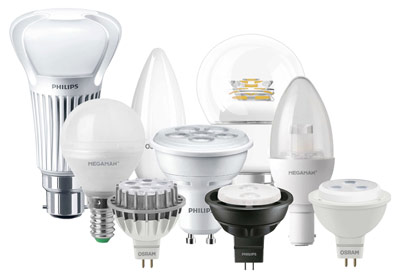What are they?

Due to the differences between LED and incandescent, halogen or fluorescent light sources buying a replacement lamp may be trickier than you expect. So you can take advantage of LED technology we’ve put together this guide to help you choose the right products. If at the end you're still not sure, then check out our LED bulb top picks for use around the home.
What should you look out for?
Efficiency & Light Output
Before we get carried away with finding the greatest energy savings, we need to make sure we’re going to pick an LED that gives us the same amount of light as the old lamp. Light output is measured in lumens so to ensure you get a like for like replacement try to match the lumen output of your old lamp with the new one.
- Not all lamps are made equal! Some manufacturers claim that their LED products are equivalent to a specific wattage, this can be misleading as light output and wattage are not comparable between bulbs of different technologies. By comparing the lumen output of the bulb you can always be sure that you will be buying an equivalent lamp.
LEDs are a very efficient light source but how do they stack up against the other alternatives? To find out you’ll need to look at the lumens per watt of the lamps, that is, how much light you get for the electricity used. Take two spotlights, one LED and the other halogen. Both produce the same light output at 400 Lumens the LED is 5 watts whereas the equivalent halogen is 28 watts. Without doing the exact maths, you can work out that the LED is over 5 times as efficient as the halogen.
It’s also important to note that LEDs are becoming more and more efficient. This means that the manufacturers can offer a lower wattage bulb to achieve the same lumen output. So a 7w may become a 5w with no drop in light output.
Rated Life
LED technology is very robust and benefits from the longest operating life of all light sources. Many of the LED products that we stock have a rated life between 10,000 to 35,000 hours. So if you have your lights on for 6 hours a day, every day of the year, a 35,000 hour lamp would last just over 16 years!
Therefore LED lamps are very low maintenance and ideal for areas where access is difficult. Whilst LED light sources are more expensive their low maintenance can offer additional savings in the cost of hiring apparatus when access is difficult.
Retrofits
Many LED products are retrofits ie they are a direct plug and play replacement for an older technology.
LED lamps are low voltage devices. A driver is used to reduce voltage to that which is required to operate the LED chip. In a retrofit LED lamp this driver is integrated into the body of the bulb. The rated voltage of the bulb will be clearly marked as 240 volts so that you will know if it is a direct retrofit with an integrated driver.
Other bulb types such as MR16, MR11 and capsule lamps operate from 12 volts and will therefore require connection to an external driver for operation.
Dimmable or non-dimmable?
Incandescent and halogen lamps are all dimmable and compatible with any dimmer but this is not the case with LED. The driver the LED uses will determine if it’s dimmable or not so it’s important to check the product specification before you buy. All our retrofit LED lamps state whether or not they are dimmable. This will also be clearly marked on any packaging.
- Not all lamps are made equal! There are several dimming systems used in the UK . The most popular being leading edge, trailing edge and phase cutting dimming systems, whilst some manufacturers claim that their product will “dim” , will it dim on all three systems that we have mentioned? At General Lamps we will only supply lamps from manufacturers that we know will have tested their products on all three systems with dimmers from the most popular suppliers so that we can be happy that our clients will receive a product that will perform as they expect. Examples of manufacturers that we use for dimming LED’s are Philips, Osram and Megaman. Theses manufacturers can also provide full lists of all the dimmers and transformers that their products work with.
Colour Temperature
Incandescent household lightbulbs or halogen lamps burn with a warm colour temperature of 2700 Kelvin. Colour temperature is measured in degrees Kelvin and the lower the figure, the warmer the light source is. LEDs are available in a range of colour temperatures, from 2700 to 6500K. The colour temperature will be clearly marked on the packaging and worth checking before you make a purchase.
When an incandescent lamp is dimmed, its colour temperature drops further to produce an almost amber glow. Megaman and Osram have created a range of household LEDs called ‘dim-to-warm’ that reduce their colour temperature from 2700 to 1800 Kelvin as they’re dimmed, mimicing an incandescent.
- Not all lamps are made equal! We’ve seen packaging where the colour temperature of the lamp is described as ‘natural white’ or ‘office white’. If the colour temperature in degrees Kelvin is not clearly stated on the pack it might be prudent to avoid making a purchase.


